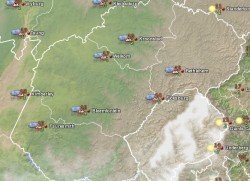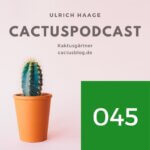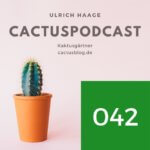Damit wir auf der Nordhalbkugel auch mal wissen, wie es im Süden gerade ist und was die als wärmeliebenden Sukkulenten für (Un-)Wetter aushalten – ein Sukkulenten-Wetterbericht aus Südafrika:
Mid june: A massive low pressure system moves south from central africa into central southern Africa bringing soaking rains to the Kalahari, the karroo and the northern Transvaal low veldt. This would be normal in summer but highly abnormal for our mid winter. This system hangs around for several days.
Last week in june. A series of cold front low pressure systema move in from the southwest atlantic bringing heavy rain and snow to the western cape which is normal for us. One of these cold frontal systems is severe with gale force winds battering the cape and than moving north east across the entire country in the process dumping more rain everywhere. Than the skies cleared and the night temperatures dropped dramatically. The only parts of southern Africa which escaped frost were the narrow coastal belt regions elsewhere.
Springbok: minus 2 C. Home to Conophytum bilobum and violaciflorum and Lithops marmorata among many other succulents.
Khamiesberge: home to Berrisfordia, Conophytum pageae, depressum, Othonna euphorboides at the higher peaks where almost certainly iced up.
Central cedarberge where the high peaks snowed in and where only a little lower Conophytum minusculum + v. leipoldtii, mundum, Pelargonium alternans, Dioscorea and Othonna minima grow.
Southern Cedarberg also reported heavy snow. Colonies of Aloe haemanthifolia were certainly covered in snow and Conophytum ceresianum and bicarinatum were likely iced in.
Sutherland – Calvinia region which lies on the escarpment and is routinely among the coldest in south Africa with a record of – 15 C at Sutherland recorded some years back. This is home to Lithops viridis, Aloinopsis spathulata, Crassula marnier-lapostollei and some Stomatium spp. among others.
All of the above regions fall under the winter rain area and this weather was about the norm occurring once or twice every winter.
The following was abnormal;
Central Karroo with temperatures of -1 to -6 C with a great many Euphorbias, Aloes, Mesembs, Haworthia etc.
Eastern freestate: Bethelehem which is already a cold place and home to Euphorbia pulvinata and clavaroides : – 5 C.
Transsvaal lowveldt including the Kruger national park : – 1 C.
This is already in the tropics and home to many tree-Euphorbias, Pachypodium saundersii and Adenium obesum.It may interest the nurserymen and hobby growers just how cold this part of the world can get and that a lot of southern African succulents are hardier than most suspect.
RR.
Über den Autor
im Podcast seit 2019
Blogger seit 2005,
Kaktusgärtner aus Passion - seit 1970,
... in einer Familie von Kaktusgärtnern seit 1822
... und Gärtner in der Blumenstadt Erfurt seit 1685






